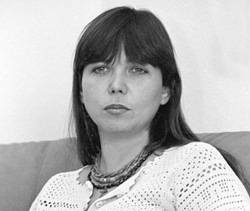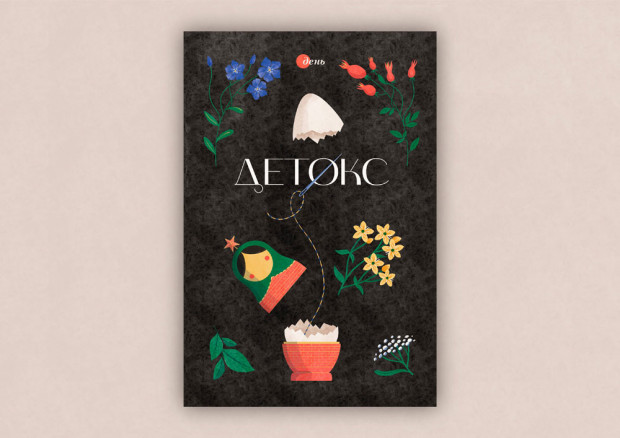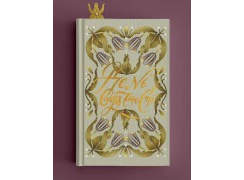Oksana MILOVZOROVA: “We have everything but self-respect”

The Milovzorovs are well known in the artistic world. Oleksandr Milovzorov is a remarkably gifted, multifaceted, and always surprising artist, whose talent and creative temperament manifest themselves in whatever he undertakes — ceramics, ranging from pedestrian kitchen utensils to enameled vases, prints or whimsical compositions.
His daughter Oksana is well known in what is best described as the narrow circles formed by reputed critics and connoisseurs. She designs pieces of jewelry on paper, which is then used by modern goldsmiths to make the real things. Every work she produces is marked by exquisite beauty and each time takes everyone by surprise, now displaying prominent heathen motives, then decadent splendor, and then pure avant-garde.
Oksana's daughter Lisa turned out the black sheep of the family by breaking with family tradition and taking up music. Who knows? She may want to try art someday. After all, Oksana started by following in her father's footsteps, graduating from the Mukhina Higher School of Art and Industry in what was then Leningrad, working porcelain for a number of years, and very successfully, and then finally concentrating on jewelry design (and the latter, unlike in all civilized countries, is kept away from the public eye here).
However, our conversation, when Oksana visited The Day , started not with her creative work but with Andriyivsky uzviz. And it was natural, first because this old narrow street means so much to Kyiv. Second, because the place and the Milovzorovs are literally inseparable. Oleksandr Milovzorov has always tried, and still does, to turn the place in a Mecca for the capital's artists. He was among the first to try to lend the Ukrainian art market a civilized touch, setting up the Triptych Gallery and later one known as 38. So what does Andriyivsky uzviz mean to his daughter?
O. M.: To me, this street is life in all its manifestations, a place I am always strongly drawn to, a place I hate to leave, and I try to make others feel like I do, I mean regular and casual visitors. I also think that all that work here are somehow involved and I know that that they are aware of this involvement.
The Day: How did Andriyivsky uzviz begin for you? What was its evolution throughout the years?
O. M.: I was a Mukhina student and I had a personal open-air exhibit (they are traditional now). It was in 1986, the year of the Chornobyl disaster. I had thoroughly prepared for the event, working hard on every ceramic souvenir. It was then my major, ceramics, and I thought that my souvenirs were brilliant works of art. Actually, I came to sell them, but what happened was a real shock. I sold practically nothing, and back in Leningrad my works were in demand (I had even started receiving commissions). After that fiasco I realized that souvenirs sell best where they are conceived and made. It was a good lesson and not only for me, I think. Today one can see craftsmen on Andriyivsky uzviz making and decorating their artifacts before one's eyes. Some, of course, bring ready products. However, the main thing is that these souvenirs must convey the Ukrainian spirit and Kyiv color, the spirit of the capital if you will. Now such souvenirs are in demand.
But then something appeared on Andriyivsky uzviz that had nothing whatever to do with the place, expensive boutiques which do not seem capable of adapting to the environs and upset the style of that street. They are from a different planet, an awkward and ridiculous intrusion. They would look fine in any other place but not here. Well, I think life itself will correct the situation.
The Day: Maybe, but Andriyivsky uzviz is primarily a host of art galleries. How do they coexist with street peddlers? It is generally believed that while the former are temples of art, the latter mainly offer kitsch.
O. M.: I think that street peddlers have every right to exist. And I know, too, that the gallery people are on quite friendly terms with them. They just have their own small “galleries” on wheels. You find the same thing all over the world. Also, every commodity eventually finds its customer. That's a law of the market. Another thing is that our galleries don't have enough room. Here space is cramped, with small galleries and peddlers literally rubbing elbows. I guess this explains the general light attitude to them. In reality, these galleries have a lot of serious works of art.
The Day: Thriving art on Andriyivsky uzviz is believed to have coincided in time with Ukraine's cultural upsurge. How does the current emotional, political, and economic decline affect this street?
O. M.: Previously, the place teemed with what looked like non-stop festivities, with craftsmen, artists, and all eager to participate, regardless of rank or standing. They would come here to communicate with the public. Of course, would brings something for sale, but I don't this had any tangible effect on their personal budget, one way or the other. But this was not important, not for them. And then everything changed. The place was now frequented by experts intending to make money. No more festivities. The atmosphere became more pragmatic. And then all this disappeared, too. People on Andriyivsky uzviz now go through the motions of selling and buying things, as very little is actually sold.
The Day: You mean the public lost interest?
O. M.: Not exactly. People can be still interested, but that's all, for they can no longer afford to buy the things they like.
The Day: A city visage is made up of more than architecture. It also the general atmosphere, people's moods, and this atmosphere includes the manner in which people dress and what decorations they wear. You must be aware of all this. So what do you like and dislike now?
O. M.: The first thing I notice in the street is that our people sport too many colorful clothes and use too many natural fabrics. This produces a head-spinning color effect, reminding one of war paint, and this style dominates both clothes and makeup. But sometimes I find myself thinking that this blinding array is because people are trying to make up for their gray daily routine and lack of positive emotions, maybe self-confidence. Often, such sartorial plactice does not depend on one's personal budget, but precisely on one's taste, or rather the lack of it. And all those “new Ukrainians” are not always heroes of anecdotes. They are different. Among them one finds people with an innate sense of style and subtle taste. Of course, there those totally without it. But they can always look through expensive wear or jewelry catalogues, although here, too, one has to know what to choose.
Different strokes for different folks, of course, but people that really know must tell others what is truly beautiful and aesthetic, and otherwise. Generally, things are really beautiful when we treat them as such. And above all how we treat ourselves. Many are careless in that department (and then we are surprised to realize that other countries look down on Ukraine). Our biggest problem is that we have never cultivated self-respect. Have you ever noticed the way we portray ourselves in our souvenirs? Obese, big-headed, potato-nosed, short-legged khokhols , grotesque ceramic figurines boasting hair-raising proportions. For some reason such an approach is considered funny and entertaining, duplicated in a multitude of such products. And what is really funny is that this stuff sells well. You will say it's self-irony. I would rather describe it as another manifestation of our inferiority complex. Why? What do we actually lack? The fact is that Ukrainians are considered very attractive representatives of the human race. We have everything but self-respect.
Such aesthetics — rather, antiaesthetics — is quickly accepted and takes root. And duplicating such ugly figurines is evidence that this antiaesthetics is firmly implanted in people's minds, and things like this are considered works of art. In fact, people don't even try to view this phenomenon critically. If deep at heart we see ourselves that way, why be surprised that others treat us as lesser beings? The situation will remain the same unless we become aware of the fact.
Americans and Europeans also have special visual codes that are strikingly different from ours. They portray themselves as supermen, athletic and forbidding. This could be another extreme, but one finds it hard to treat them lightly, let alone humiliate them.
All this has a most direct bearing on my profession. In choosing pieces of jewelry, fine or costume, one strives to make oneself look better, even more attractive than one really is. But here all depends on one's self-awareness, self-concept.
The Day: Actually, what does jewelry mean to a person? Is it a sign of luxury, an attribute of prestige, social standing, or a means of self- expression?
O. M. A bit of everything. For some it is just to show how rich and famous they are. For others, a way to make oneself look more attractive. Yet the symbolism of such decorations reaches far deeper. At the empirical level I regard them as amulets to ward off evil spirits and dark forces. Graphic symbols originating from Old Rus, the Northeast, or Scandinavia all have special meaning, largely protective for the bearer. A lot of their elements are used in modern jewelry, although they are quite meaningless now. What I mean, for centuries on end such decorations had been a priori valued not by the precious metal from which they were made or the amount of work put into them, but according to the symbols they bore, and they would be handed down for generations. This, by the way, started the family jewelry tradition lost under the Soviets, like so many other things.
The Day: Is there a notion like fashion in the jeweler's art?
O. M.: There are, of course, certain trends and styles that tend to evolve. Italian and Israeli designs are known all over the world. In France, the situation is different. In that country every couturier, wishing to keep his garments in one style, also makes shoes, fittings, and pieces of jewelry. For long years our artists were placed in a confined space. We saw very little in the way of avant-garde and only heard about what was happening in the United States or Japan. Now the situation has changed. We have unlimited access to information and one can buy practically anything. However, I'm not quite sure that, say, the Italian style (which is very good, of course) will do us justice.
As for my works, I consider Old Rus an inexhaustible source of inspiration. It implies the authentic, original, primordial style. At the same time, it blends well with avant-garde motifs. Sometimes I found myself strongly attracted to the play of forms, although there are a lot of designer's techniques — for example, in Italy — and they are all quite interesting. Yet I always want to do something different from everyone else.
The Day: Is there a Ukrainian national tradition in jewelry? Maybe using some special materials or stones?
O. M.: It is generally believed (and very wrongly!) that coral is inherently our national decoration. As a matter of fact, coral is also used in Italy, India, Serbia, and is worn by people all over the world. Talking of the specifics of Ukrainian jewelry, decorativeness is the first thing that comes to mind.
Our pieces of jewelry often portray images akin to those practiced in Kyiv Rus: people, interwoven ornaments. Many believe this a shortcoming, but I think it is a great advantage, for it gives one a sense of freedom and ease in handling the material. Our ancient craftsmen used gold not because it was precious material, but because it was good material, solid, reliable, and convenient. And so their works turned out fascinating, without all those frills and polished techniques resulting in an emotional void.
The Day: Are these traditions upheld by modern artists?
O. M.: Unfortunately, there is a trend to imitate Western design in secular art. In the religious sphere, we still have our own original imagery, rough surface, or just simple images but very saturated and colorful.
The Day: Making sketches, what materials do you usually have in mind? Precious stones? Gems?
The Day: I have in mind only our Ukrainian stones: topaz, beryl, smoky quartz. Theirs are not bright colors, but they are large and in many respects set the tone of the composition.
O. M.: Actually, whatever material I use, its monetary value is not important. It can be a chunk of clay, paper, whatever. Monetary value is nonexistent for me. I might as well use steel. By the way, the first brooch made of aluminum and presented to one of the Russian tsars cost a fortune. The value of the material as such is very conditional. For me, aesthetic worth is far more important: the warm white color of silver, varying shades of gold, their combinations. The freer one feels applying them (keeping within certain technical parameters, of course), the easier the result and closer to real art, rather than craftsmanship.
The Day: What do you think Ukraine needs to make its national style fashionable?
O. M.: This brings us back to the notion of self-respect and consciousness of one's own worth. If we become fully aware of all this, we will develop our own style, and not only in art.
Perhaps we should start with our traditional respect for everything foreign. If something we do is recognized and becomes popular abroad, it is instantly a success at home.
The Day: The kind of regime we have is not geared to let one earn a decent living doing a decent job. Over the past eight years people have grown miserable rather than become normal citizens receiving normal pay and paying normal taxes. Some of them could have long ago opened art salons on Khreshchatyk and sell real things, not the horrible stuff we have on sale now — all that cheap Chinese and Turkish merchandise. And we could have produced names, and those people could have started getting our customers accustomed to real Ukrainian quality.
O. M.: We certainly have names worth being made internationally known: Yevhen Zavarzin, Vitaly Khomenko, etc. But many have left Ukraine. And what we have now is a situation in which pieces of jewelry start being made not by artists but craftsmen. They may be of good quality, but they lack creative imagination, knowledge, even talent. So what they make is consumer goods, not works of art. And people treat them as such. In reality, the jeweler's art is born not on a store counter but in a museum like the Hermitage in St. Petersburg or GrЯne Gewelbe in Dresden with their collections of Venetian, German, English, and French jewelry dating from the fifteenth century or thereabouts. There are excellent items on display at the Kyiv History Museum. But people to not go there to look at them. They go to the store with all its wares from Italy.
The Day: You impress one as a person with no problems, even our domestic upheavals and hardships seem to have avoided you. Does this mean that you have found your philosopher's stone?
O. M.: Of course not. We cannot break free from the surrounding realities. But I generally consider myself a lucky woman. For example, I can easily put up with a lack of comfort, household amenities, or money, but becoming disillusioned with people makes me suffer, and I hate injustice with all my heart.
Daddy says that if you are an artist you will stay one even if locked in a cellar, without paper or pencil, for you will start drawing on the wall, using chalk or something. Now that I have mastered my form I don't have to distract myself trying to find it. I just look at a sheet of paper and know the subject and its formal depiction, because any sign, any line, any spot left on paper is a trace of emotion, one's inner life. The main thing for me is to lend all this a certain shape, make it material. In this domain I don't want to depend on the state, ideology, or restrictions (any help is out of the question). I myself need what I do, and if someone is not interested, fine. Let him look the other way. So long as he doesn't get in my way. If an artist is not allowed to develop free, it gets to be a personal tragedy of the artist, but in that case the state also stands to lose much. Say, Ukrainian sculpture is known in the world thanks to Oleksandr Arkhypenko (known in the West as Alexander Archipenko) and only because he could work and made his name in America, as an ОmigrО. Ukraine lost a great artist and no one felt sorrow. But the fact is that there is no other sculptor of his caliber in Ukraine. I could give you many other examples.
I am happy because I have my art and it is my means and method of communicating with the world around me.
The Day: And how does the world respond?
O. M.: So far with love.
Newspaper output №: Section






